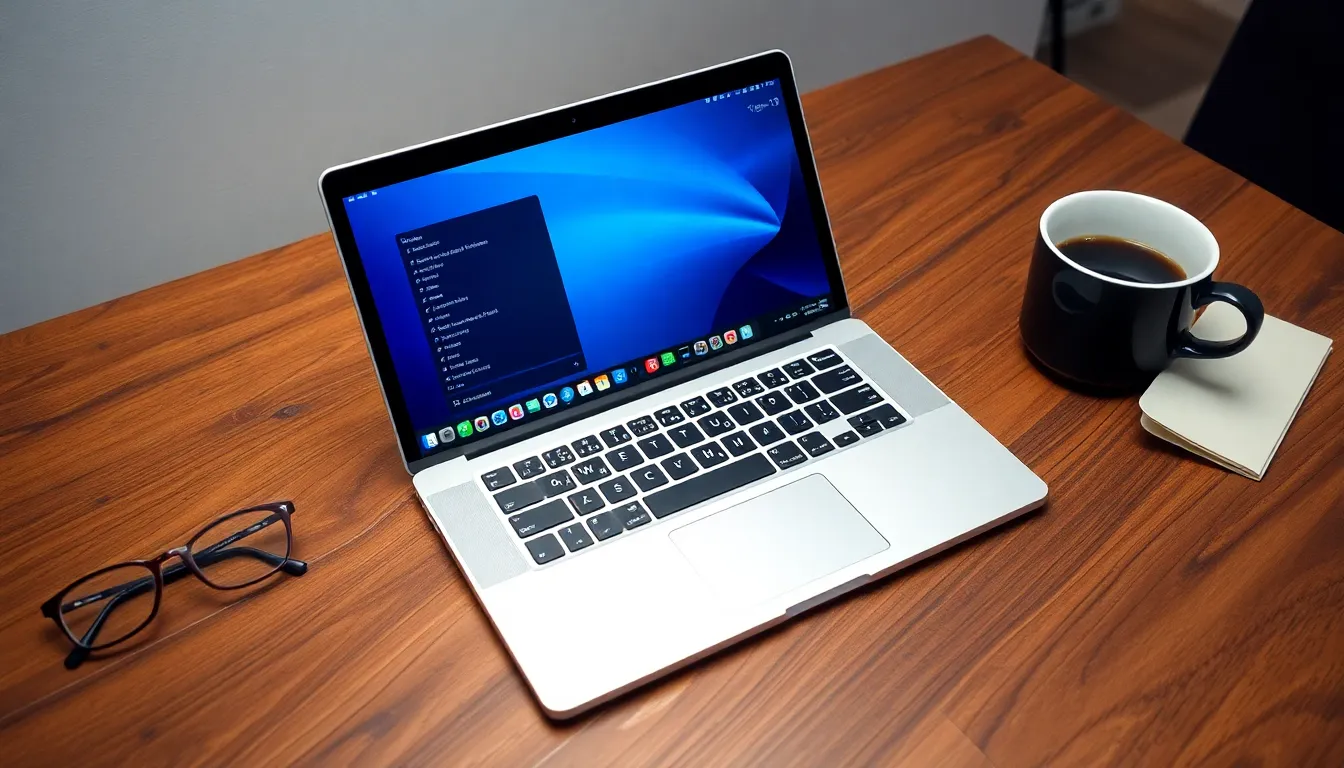In a world where laptops often come with a hefty price tag and endless software updates, Chromebooks burst onto the scene like a breath of fresh air. These sleek, lightweight devices offer a simple yet powerful solution for anyone tired of tech headaches. With a user-friendly interface and seamless integration with Google services, it’s no wonder they’ve become the go-to choice for students, professionals, and casual users alike.
Imagine a laptop that boots up in seconds, runs on the cloud, and doesn’t require a degree in computer science to operate. Chromebooks make that dream a reality. They’re perfect for browsing, streaming, and even some light gaming—without breaking the bank. So why not trade in that old clunker for something that’s not just smart, but also a little bit sassy? Dive into the world of Chromebooks and discover why they might just be the tech upgrade you never knew you needed.
Table of Contents
ToggleOverview of Chromebooks
Chromebooks operate on Chrome OS, a lightweight operating system designed for speed and simplicity. Users can expect quick boot times, often under 10 seconds, enhancing productivity. Many models feature solid-state drives (SSDs) for faster data access, typically offering 16GB to 128GB of storage.
Affordability defines the Chromebook market. Prices range from $200 to $600, depending on specifications and features. This competitive pricing appeals to budget-conscious consumers, particularly students and educators.
Connectivity options remain plentiful. Most Chromebooks include USB Type-C, USB-A, and HDMI ports, facilitating various peripheral connections. Wi-Fi 5 or Wi-Fi 6 capabilities ensure reliable internet access in diverse environments.
Battery life impresses, often lasting anywhere from 8 to 15 hours on a single charge. Such longevity supports continuous use for both learning and work without frequent recharging.
Though primarily cloud-based, Chromebooks support offline functionality. Applications like Google Docs and Gmail allow users to work without internet access, syncing changes once connectivity resumes.
Security features are robust. Regular automatic updates protect users from vulnerabilities, while built-in virus protection keeps systems safe. The Chromebook’s sandboxing technology isolates harmful software, enhancing overall security.
Many educational institutions embrace Chromebooks due to their manageable features and tools. Google Classroom integration streamlines assignments and collaboration between teachers and students. This fosters an engaging learning environment.
Versatile usage suits various needs. From light browsing to document editing, Chromebooks make multitasking seamless. They reflect advancements in technology focused on efficiency and ease of use, making them an appealing choice for anyone seeking a reliable computing solution.
Features of Chromebooks

Chromebooks offer a range of features tailored for efficiency and usability.
Design and Build Quality
Design elements prioritize portability and durability. Many models feature lightweight materials, making them easy to carry. Displays often come in sizes ranging from 11 to 14 inches, balancing screen visibility and portability. Some Chromebooks include touchscreen capabilities, enhancing user interaction. Build quality emphasizes resilience, with many devices meeting military specifications for toughness. Colors and styles vary, appealing to diverse preferences.
Operating System and Software
Chrome OS provides a streamlined experience built for speed. Regular updates keep the system secure and efficient, addressing any vulnerabilities. Users can access a vast library of applications through the Google Play Store and Chrome Web Store. Most pre-installed applications offer offline functionality, ensuring usability without internet access. Users benefit from seamless integration with Google services, including Google Drive and Google Docs. Some Chromebooks come with a suite of productivity and educational tools designed for enhanced user experience.
Performance and Usability
Chromebooks excel in performance and usability, making them popular among various users. Their impressive battery life and speed contribute significantly to their appeal.
Battery Life
Battery performance captures attention with a remarkable lifespan between 8 to 15 hours. Users rely on this extended endurance, which allows for uninterrupted work or play. Many students prefer Chromebooks for their capability to last through long school days without needing a charge. Apps function effectively, optimizing battery usage further. Factors like screen brightness and running applications can influence usage time. Overall, reliable battery life enhances productivity, enabling users to focus on tasks without worrying about power.
Speed and Responsiveness
Speed and responsiveness stand out as key advantages of Chromebooks. Boot times can be as short as 10 seconds, facilitating a quick start for users. They operate on Chrome OS, designed specifically for fast and efficient performance. Applications launch rapidly, ensuring minimal waiting time. Surfing the web feels fluid, enhanced by lightweight browser capabilities. In classrooms or office settings, quick responsiveness allows for seamless multitasking. By prioritizing efficiency, Chromebooks provide a smooth user experience that meets everyday demands.
Comparison with Other Laptops
Chromebooks stand out against traditional laptops due to their unique features and capabilities.
Chromebooks vs. Windows Laptops
Performance differences shape user experiences between Chromebooks and Windows laptops. Chromebooks operate on Chrome OS, which prioritizes speed with boot times under 10 seconds. Meanwhile, Windows laptops often require more time to start up and manage system resources. Affordability plays a significant role; Chromebooks range from $200 to $600, making them budget-friendly choices for students. Windows laptops can start around $300 but often exceed $500 for similar specifications. Connectivity options vary as well; Chromebooks typically feature USB Type-C and HDMI ports, while Windows laptops provide more diverse connections. Battery life favors Chromebooks, lasting between 8 to 15 hours compared to around 5 to 10 hours for many Windows devices. Overall, Chromebooks cater to users prioritizing simplicity and efficiency.
Chromebooks vs. MacBooks
Comparing Chromebooks and MacBooks reveals distinct advantages and challenges. MacBooks operate on macOS, offering a robust ecosystem with extensive software compatibility, including advanced applications. In contrast, Chromebooks focus on web-based functionality, making them ideal for users relying on cloud applications. Price significantly differentiates the two; MacBooks typically range from $999 to $2,499, positioning them as premium devices. Chromebooks, priced between $200 and $600, appeal to cost-conscious consumers. Build quality plays a role as well, with MacBooks known for their premium materials and sleek designs, while Chromebooks prioritize portability and durability. Battery life remains a strong point for both, but Chromebooks generally excel with 8 to 15 hours of use, compared to roughly 10 to 20 hours on MacBooks. These differences help users determine which device better suits their needs.
Use Cases for Chromebooks
Chromebooks cater to a variety of users due to their unique features and affordability. They excel in environments that prioritize simplicity and collaboration.
Education
Chromebooks serve as an essential tool in educational settings. Schools favor these devices for their affordability, making them accessible for students. Many Chromebooks come equipped with Google Classroom integration, enhancing the learning experience. Students appreciate easy access to cloud-based applications, which fosters collaboration and submission of assignments remotely. Teachers benefit from the manageable interface and ongoing updates that keep devices secure and efficient. With battery life lasting 8 to 15 hours, students rely on Chromebooks for long school days without frequent recharging. Overall, their design promotes an engaging and productive classroom environment.
Business
Chromebooks also find a prominent place in the business sector. Professionals appreciate the lightweight design and fast boot times that allow for seamless transitions between tasks. Many offices equip employees with these devices for cost-effectiveness and ease of use. The cloud-based features enable team collaboration through applications like Google Workspace, streamlining workflows. Regular security updates ensure sensitive data remains protected. Users enjoy impressive battery life, allowing for long hours of work without interruptions. The combination of affordability and functionality makes Chromebooks an appealing choice for small and large businesses alike.
Chromebooks stand out as a versatile and budget-friendly option for users seeking efficiency and simplicity. Their lightweight design and impressive battery life cater to both students and professionals, making them ideal for various environments. With seamless integration of Google services and a robust app ecosystem, these devices enhance productivity and collaboration.
The security features and regular updates ensure peace of mind for users, while the quick boot times and responsive performance elevate the overall experience. As technology continues to evolve, Chromebooks remain a compelling choice for those looking to embrace a modern computing solution.





